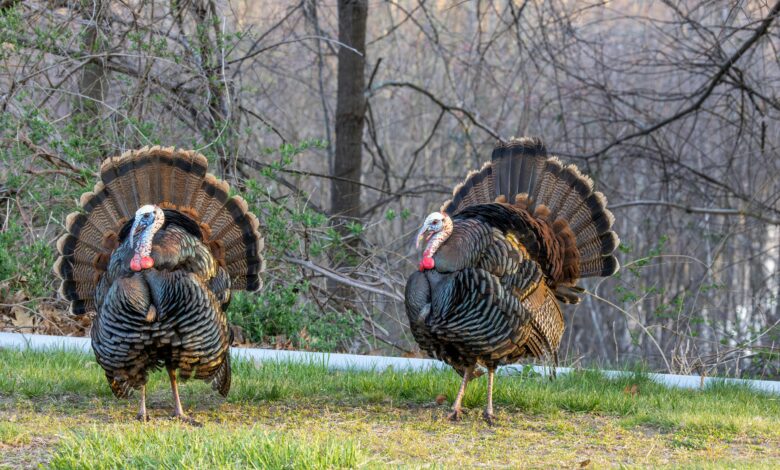Turkey Mating Season and Early Season Hunting Challenges

During the opening days of the turkey season, there is a lot of excitement in the air. But spring turkey hunting comes with its own set of obstacles. Some mornings, you can hear the tom gobbling its head off. But the next morning the weather can turn foul and the woods fall silent.
For any hunter, overcoming these challenges requires a basic understanding of the turkey mating season and its dependence on the weather. Knowing all about it gives you an edge and helps you choose the right tactics.
Here, we will discuss the wild turkey mating season and turkey social hierarchy. In addition, we will share some expert tips on tackling weather-related variables during a spring hunt.
When is Turkey Breeding Season?
The exact timing of the turkey breeding season can vary depending on the species and location. Across the US, the turkey breeding season is from February to early June. In most states, the spring hunt begins in March or April. However, it is delayed in the northern states to match the turkey behavior.
Turkey flocks start breaking up as winter ends with toms and hens heading for their strutting grounds and breeding grounds respectively. In the southern regions, the period between mid-March to early April is the peak gobbling time. In the north and west, this period covers the entire month of April.
The gobbling peak occurs during the primary courtship period. Once the toms have gathered a harem of hens, gobbling comes down and the mating phase begins.

How Does Turkey Mating Work?
If you do not know this already, turkeys are flock animals. The large flocks break up into smaller units only during the breeding season. The first phase of breeding involves the setting up of a social hierarchy through shuffling around and fighting.
While the gobblers are pumped up by their hormones at this period, the hens are not yet ready to breed. Ultimately, the gobblers fight with each other to establish territories and gather a small breeding flock of hens.
Once they are ready, the hens are extremely selective and only the dominant tom is allowed to mate with her. Only one gobbler in a group will mate while others act as bodyguards. The term monogamy does not exist for turkeys and gobblers breed with multiple hens when the timing is right. Even the hens might breed with more than one alpha tom.
The life expectancy of a wild turkey depends on multiple factors. The average number is four years for a tom and three years for a hen. Even though turkeys can start breeding from the age of one, young males find it difficult to compete with the older ones.
So, the Jakes have no role in mating and live on the fringes. That makes these lonely Jakes the easiest birds to call. On the other hand, separating a boss gobbler from his hard-won harem by calls is not easy.
Once the mating is over, the hens start nesting. Hunting gets tougher as gobblers do not announce their presence at this stage. Once the eggs are laid, the hens drop all association with the gobblers. Each hen can lay around 10-12 eggs and the turkey gestation period is around 28 days. In case the nesting fails, a hen may reappear on the mating scene.
The second gobbling peak, as it is popularly called, starts once the hens incubate their eggs and the old tom starts feeling lonely again. Even though they go back to their bachelor days and start gobbling, the hunter-shy turkeys tend to be more cautious during this period.
If most of the toms in the area have become hunter-shy, try using turkey decoys, or, even better, get closer to the roost. However, I have found some toms to be desperate in this period as the number of hens is less.
Turkey Dominance and Pecking Order
Do you think turkeys are passive, easy-going birds?
Wrong! The social hierarchy of turkeys is based on dominance and its main purpose is to facilitate the breeding process. This hierarchy is fortified through the proverbial “pecking order”. More than often, the old boss starts pecking at the subordinates in their flock. Lower-ranking males in this hierarchy have fewer chances of getting close to the hens.
Establishing this hierarchy often leads to violence which the toms do not shy away from. And if you have seen a turkey fight, you will know that it is absolutely savage. On the other hand, female turkeys are not so obsessed with dominance or pecking order and when interactions involve less violence.
As the turkey mating season, you might find the birds responding aggressively to shiny objects. The reason is simple- they consider the reflection as an opponent.
Jakes leave the family flock voluntarily and associate with other birds of their class. This can be nature’s way of managing things. Since they are aggressive and reckless at this stage, the Jakes might endanger the hen by staying with the flock. At times, a team of Jakes can behave like a “street gang” and pound a lone tom.
And what about the gobblers that have been defeated in battle? Generally, such birds do not attempt to rejoin the group. However, I have seen such expelled birds rejoin the groups after some sort of turkey peace treaty was worked out.
Even after the birds have set up the social order, you might find a solo longbeard who is old enough to prefer hanging out alone. Chances are, the bird will have predictable patterns that you can figure out. Such a lone gobbler can be the perfect target.
How Weather Impacts Turkey Mating
The common idea is that unusual spring conditions can affect turkey mating patterns. But, in reality, it is not so. Gobbling is often triggered by warm weather, but it is increasing daylight or photoperiod that stimulates the hens to breed.
Even if the males start gobbling early, hens hardly pay any attention to that. The point is, a hen’s timing has to be right to ensure that the poults have plenty to eat when the eggs hatch.
Sudden cold waves late in the season can slow down courtship activity, especially during the early morning hours. Gobbling can also be reduced if the weather is cloudy or windy. However, as the day progresses and the temperature rises, the toms start gobbling again. The birds descend from their nest in the mid-morning and seek out spots warmed by the sun.
Generally, heavy precipitation can bring down gobbling activity to zero. Once the rain intensity drops, I have found the birds avoiding vegetation and sticking to meadows, pastures, and agricultural lands. Possibly, better visibility in open areas makes them feel safer. As the weather clears, you can expect the mating activity to gain momentum again.
When it comes to nest survival rates, one study has indicated that it is not affected by the rise in precipitation and temperature. This has pointed to the possibility that climate change can increase the turkey population.
The question is, how does poor weather impact your early-season turkey hunting strategy?
While dealing with bad weather or an early spring it is important to understand how the weather is impacting the birds. For that, spending time in the field is crucial. Also, pack the turkey hunting essentials to meet the conditions and stay comfortable.
In case of poor weather, veteran hunter Art Helin suggests setting up a ground blind in an open area and using box calls as they are louder.
Since wind and rain dampen the sound, a louder call will reach out further. Waterproof calls are the best options. During the dominance phase, a hen and Jake turkey decoy can work well. They will distract the turkeys from the blind.
Note, that lousy weather will also impact evening turkey hunting sessions as roosting can get difficult. If you are planning an ambush strategy, make sure that the visibility is right. Think of choosing turkey hunting loads with powerful primers to lessen the effects of low temperature and dampness.
That said, staying patient and resisting the urge to act too soon is important. If you spook a tom early in the season, the chances of calling it in the remaining months drop considerably.
Another option is utilizing elevation to locate the birds. Art mentions that moving towards the birds from a low point can be counterproductive as the birds will pick you out easily with their super sharp vision. Early morning, head to a ridge top to locate the birds and then plan your approach.

Approximate Turkey Mating Season by Location
Here is a look at the breeding seasons for the different species and locations.
Eastern Wild Turkey
In the south, the breeding for this species begins in late February or early March. In the northern states, it starts in April. Hatching begins in June and can extend till mid-summer up north.
Florida (Osceola) Wild Turkey
For the Osceola, gobbling and strutting begins in mid-February, In Florida, this can begin as early as January due to warm spells. The actual breeding begins 3-4 weeks later when the hens become receptive. After the hens lay their eggs, hatching begins in early May.
Merriam’s Wild Turkey
The natural location for the Meriam’s is the western, Rocky Mountain region and they move to higher elevations during summer to breed. Generally, the breeding period is between mid-March and April, but it can vary depending on snow conditions.
Rio Grande Wild Turkey
The Rio Grande starts mating activity in March and by the end of April hens are looking for nesting cover. The eggs hatch by the end of May or early June.
Final Thoughts
Spring turkey hunting can be challenging but that is what makes it a lot of fun. Plus, you will surely learn a ton of new things about the turkey mating season while tackling rough weather conditions.
Since no two wild turkeys behave in the same manner, you need to stay alert at all times. Even though turkeys are driven by hormones in this period, you cannot afford to put the wrong foot forward. Have a plan and do not let the urgency to harvest make you commit a mistake.
So, go out there and have fun.



2 Comments